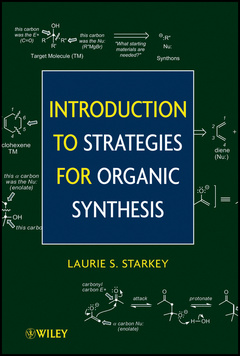Description
Introduction to the strategies of organic synthesis
Author: STARKEY Laurie
Language: English
Subject for Introduction to the strategies of organic synthesis:
Approximative price 51.36 €
In Print (Delivery period: 14 days).
Add to cart400 p. · Paperback
Description
/li>Contents
/li>
1.1 RETROSYNTHETIC ANALYSIS
1.2 PROTECTIVE GROUPS
PART I PROBLEMS (PROTECTIVE GROUPS)
PART II SYNTHETIC TOOLBOX 2: OVERVIEW OF ORGANIC TRANSFORMATIONS
2.1 NUCLEOPHILES AND ELECTROPHILES
2.2 OXIDATION AND REDUCTION REACTIONS
PART II PROBLEMS (NUCLEOPHILES, ELECTROPHILES AND REDOX)
PART III. SYNTHESIS OF MONOFUNCTIONAL TARGET MOLECULES (1-FG TM"S)
3.1 SYNTHESIS OF ALCOHOLS (ROH)
3.2 SYNTHESIS OF ALKYL (RX) AND ARYL HALIDES (ArX)
3.3 SYNTHESIS OF ETHERS (ROR")
3.4 SYNTHESIS OF THIOLS (RSH) AND THIOETHERS (RSR")
3.5 SYNTHESIS OF AMINES (RNH2) AND ANILINES (ArNH2)
3.6 SYNTHESIS OF ALKENES (R2C=CR2)
3.7 SYNTHESIS OF ALKYNES (RC=CR")
3.8 SYNTHESIS OF ALKANES (RH)
3.9 SYNTHESIS OF ALDEHYDES AND KETONES (RCHO, R2C=O)
3.10 SYNTHESIS OF CARBOXYLIC ACIDS (RCO2H)
3.11 SYNTHESIS OF CARBOXYLIC ACID DERIVATIVES
PART III PROBLEMS (1-FG TM"S)
PART IV SYNTHESIS OF TARGET MOLECULES WITH TWO FUNCTIONAL GROUPS (2-FG TM"S)
4.1 SYNTHESIS OF ß-HYDROXY CARBONYLS AND ,ß-UNSATURATED CARBONYLS
4.2 MORE ENOLATE REACTIONS: SYNTHESIS OF 1,3-DICARBONYLS, 1,5-DICARBONYLS AND CYCLOHEXENONES
4.3 "ILLOGICAL" DISCONNECTIONS: UMPOLUNG (POLARITY REVERSAL)
PART IV PROBLEMS (2-FG TM"S)
PART V SYNTHESIS OF AROMATIC TARGET MOLECULES
5.1 ELECTROPHILIC AROMATIC SUBSTITUTION (ArH + E+ -> ArE)
5.2 SYNTHESIS OF AROMATIC TM"S VIA DIAZONIUM SALTS (ArN2+ + Nu -> ArNu)
5.3 NUCLEOPHILIC AROMATIC SUBSTITUTION (ArX + Nu: -> ArNu)
PART V PROBLEMS (AROMATIC TM"S)
PART VI SYNTHESIS OF COMPOUNDS CONTAINING RINGS
6.1 SYNTHESIS OF CYCLOPROPANES
6.2 SYNTHESIS OF CYCLOBUTANES
6.3 SYNTHESIS OF 5-MEMBERED RINGS (RADICAL CYCLIZATION REACTIONS)
6.4 SYNTHESIS OF 6-MEMBERED RINGS (DIELS-ALDER REACTION)
PART VI PROBLEMS (CYCLIC TM"S)
PART VII PREDICTING AND CONTROLLING STEREOCHEMISTRY
7.1 REACTIONS THAT FORM RACEMATES
7.2 SN2 MECHANISM: BACKSIDE ATTACK
7.3 ELIMINATION MECHANISMS
7.4 ADDITIONS TO ALKENES AND ALKYNES
7.5 ADDITIONS TO CARBONYLS
7.6 ADDITIONS TO ENOLATES: ALDOL STEREOCHEMISTRY
7.7 ENANTIOSELECTIVITY AND ASYMMETRIC SYNTHESES
PART VII PROBLEMS (STEREOCHEMISTRY)
SOLUTIONS TO PROBLEMS




